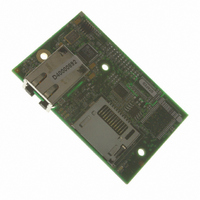20-101-1139 Rabbit Semiconductor, 20-101-1139 Datasheet - Page 21

20-101-1139
Manufacturer Part Number
20-101-1139
Description
RCM4310 RABBITCORE
Manufacturer
Rabbit Semiconductor
Datasheet
1.20-101-1139.pdf
(124 pages)
Specifications of 20-101-1139
Module/board Type
MPU Core Module
Product
Microcontroller Modules
Data Bus Width
8 bit
Core Processor
Rabbit 4000
Clock Speed
58.98 MHz
Interface Type
Ethernet
Flash
1 MByte
Timers
10 x 8 bit
Operating Supply Voltage
3.3 V
Board Size
72 mm x 47 mm x 21 mm
For Use With/related Products
RCM4310
Lead Free Status / RoHS Status
Lead free / RoHS Compliant
Other names
316-1142
Available stocks
Company
Part Number
Manufacturer
Quantity
Price
3.2.3 Serial Communication
The following sample programs are found in the
•
•
•
RabbitCore RCM4300 User’s Manual
FLOWCONTROL.C
CTS/RTS flow control with serial data coming from Serial Port D (TxD) at 115,200
bps. The serial data received are displayed in the
To set up the Prototyping Board, you will need to tie TxD and RxD
together on the RS-232 header at J4, and you will also tie TxC and
RxC together using the jumpers supplied in the Development Kit as
shown in the diagram.
A repeating triangular pattern should print out in the
The program will periodically switch flow control on or off to demonstrate the effect of
flow control.
If you have two Prototyping Boards with modules, run this sample program on the
sending board, then disconnect the programming cable and reset the sending board so
that the module is operating in the Run mode. Connect TxC, TxD, and GND on the
sending board to RxC, RxD, and GND on the other board using jumper wires, then,
with the programming cable attached to the other module, run the sample program.
PARITY.C
repeatedly sending byte values 0–127 from Serial Port C to Serial Port D.
The program will switch between generating parity or not on Serial
Port C. Serial Port D will always be checking parity, so parity errors
should occur during every other sequence.
To set up the Prototyping Board, you will need to tie TxC and RxD together on the
RS-232 header at J4 using one of the jumpers supplied in the Development Kit as
shown in the diagram.
The Dynamic C
SERDMA.C
fer to the serial port and vice versa. The Dynamic C
clear the buffer.
Before you compile and run the sample program, you
will need to connect the RS-232 header at J4 to your PC
as shown in the diagram using the serial to DB9 cable
supplied in the Development Kit.
Once you have compiled and run the sample program,
start Tera Term or another terminal emulation program
to connect to the selected PC serial port at a baud rate of
115,200 bps. You can observe the output in the Dynamic C
STDIO window as you type in Tera Term, and you can
also use the Dynamic C STDIO window to clear the buf-
fer.
The Tera Term utility can be downloaded from
hp.vector.co.jp/authors/VA002416/teraterm.html.
—This program demonstrates the use of parity modes by
— This program demonstrates using DMA to transfer data from a circular buf-
STDIO
—This program demonstrates how to configure Serial Port C for
window will display the error sequence.
SAMPLES\RCM4300\SERIAL
STDIO
STDIO
STDIO
window.
window is used to view or
window.
folder.
21


















